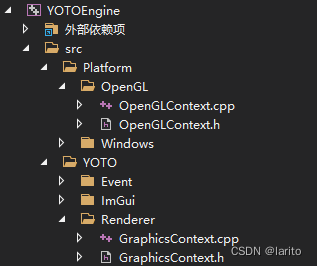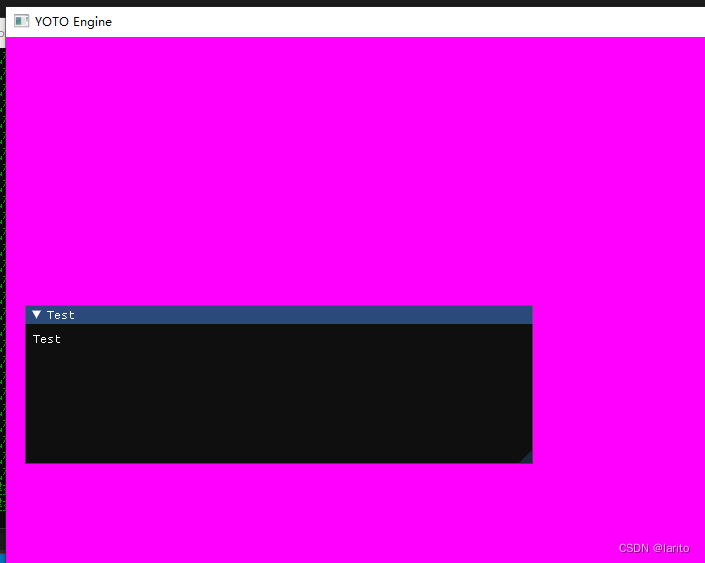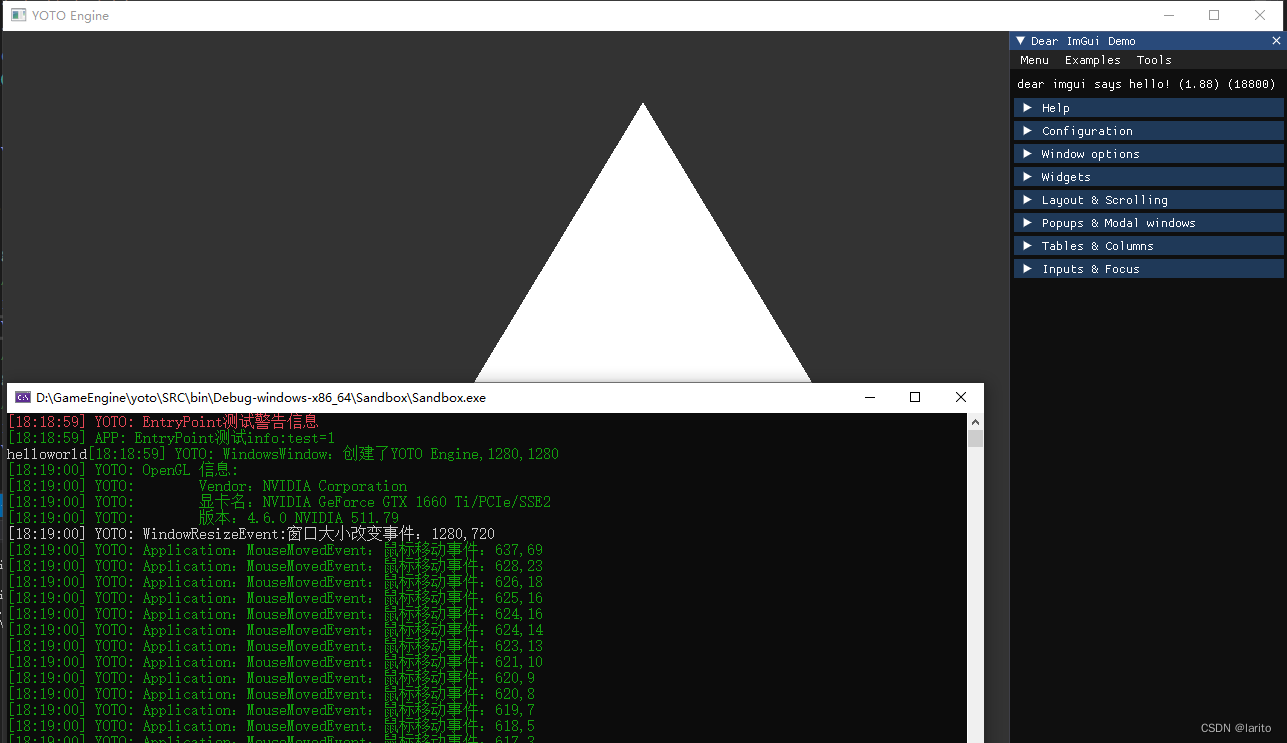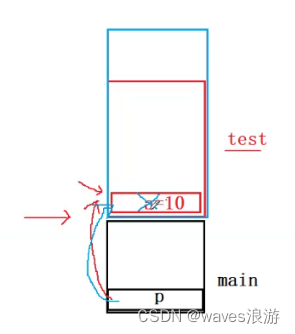本文介绍: 游戏引擎,cherno,c++,opengl,contex,上下文,第一个三角形
渲染上下文:
目的:修改WindowsWindow的结构,把glad抽离出来
WindowsWindow.h:新建m_Context
#pragma once
#include "YOTO/Window.h"
#include <YOTO/Renderer/GraphicsContext.h>
#include<GLFW/glfw3.h>
#include"YOTO/Log.h"
struct GLFWwindow;
namespace YOTO {
class WindowsWindow :public Window
{
public :
WindowsWindow(const WindowProps& props);
virtual ~WindowsWindow();
void OnUpdate() override;
inline unsigned int GetWidth() const override { return m_Data.Width; };
inline unsigned int GetHeight() const override { return m_Data.Height; };
inline void SetEventCallback(const EventCallbackFn& callback)override
{ m_Data.EventCallback = callback; };
void SetVSync(bool enable) ;
bool IsVSync()const;
//返回window
inline virtual void* GetNativeWindow() const { return m_Window; }
private:
virtual void Init(const WindowProps& props);
virtual void ShutDown();
private:
GLFWwindow* m_Window;
GraphicsContext* m_Context;
struct WindowData {
std::string Title;
unsigned int Width, Height;
bool VSync;
EventCallbackFn EventCallback;
};
WindowData m_Data;
};
}
WindowsWindow.cpp:把glad的API全部替换成m_Context的方法:
#include "ytpch.h"
#include "WindowsWindow.h"
#include"YOTO/Event/ApplicationEvent.h"
#include"YOTO/Event/MouseEvent.h"
#include"YOTO/Event/KeyEvent.h"
#include"Platform/OpenGL/OpenGLContext.h"
namespace YOTO {
static bool s_GLFWInitialized = false;
Window* Window::Creat(const WindowProps& props) {
return new WindowsWindow(props);
}
WindowsWindow::WindowsWindow(const WindowProps& props) {
Init(props);
}
WindowsWindow::~WindowsWindow() {
ShutDown();
}
void WindowsWindow::Init(const WindowProps& props) {
m_Data.Title = props.Title;
m_Data.Width = props.Width;
m_Data.Height = props.Height;
YT_CORE_INFO("WindowsWindow:创建了{0},{1},{2}", props.Title, props.Width, props.Height);
if (!s_GLFWInitialized) {
int success = glfwInit();
YT_CLIENT_ASSERT("WindowsWindow:不能创建新的glfw,{0}",success );
glfwSetErrorCallback([](int error_code, const char* description) {
YT_CORE_ERROR("WindowsWindow:GLFW错误:错误码({0}):{1} ", error_code, description);
});
s_GLFWInitialized = true;
}
m_Window = glfwCreateWindow((int)props.Width, (int)props.Height, m_Data.Title.c_str(), nullptr, nullptr);
m_Context = new OpenGLContext(m_Window);
m_Context->Init();
glfwSetWindowUserPointer(m_Window, &m_Data);
SetVSync(true);
//GLFW回调,每次改变调用lambda里的部分
//窗口大小回调
glfwSetWindowSizeCallback(m_Window, [](GLFWwindow* window, int width, int height) {
WindowData& data=*(WindowData*)glfwGetWindowUserPointer(window);
data.Width = width;
data.Height = height;
WindowResizeEvent event(width, height);
//调用回调函数
data.EventCallback(event);
});
//窗口关闭回调
glfwSetWindowCloseCallback(m_Window, [](GLFWwindow* window) {
WindowData& data = *(WindowData*)glfwGetWindowUserPointer(window);
WindowCloseEvent event;
data.EventCallback(event);
});
//键盘按键回调
glfwSetKeyCallback(m_Window, [](GLFWwindow* window, int key, int scancode, int action, int mods) {
WindowData& data = *(WindowData*)glfwGetWindowUserPointer(window);
switch (action) {
case GLFW_PRESS:
{
KeyPressedEvent event(key, 0);
data.EventCallback(event);
break;
}
case GLFW_RELEASE:
{
KeyReleasedEvent event(key);
data.EventCallback(event);
break;
}
case GLFW_REPEAT:
{
KeyPressedEvent event(key, 1);
data.EventCallback(event);
break;
}
}
});
//鼠标按键回调
glfwSetMouseButtonCallback(m_Window, [](GLFWwindow* window, int button, int action, int mods) {
WindowData& data = *(WindowData*)glfwGetWindowUserPointer(window);
switch (action)
{
case GLFW_PRESS:
{
MouseButtonPressedEvent event(button);
data.EventCallback(event);
break;
}
case GLFW_RELEASE:
{
MouseButtonReleasedEvent event(button);
data.EventCallback(event);
break;
}
}
});
//滚轮回调
glfwSetScrollCallback(m_Window, [](GLFWwindow* window, double xoffset, double yoffset) {
WindowData& data = *(WindowData*)glfwGetWindowUserPointer(window);
MouseScrolledEvent event((float)xoffset, (float)yoffset);
data.EventCallback(event);
});
//鼠标位置回调
glfwSetCursorPosCallback(m_Window, [](GLFWwindow* window, double xpos, double ypos) {
WindowData& data = *(WindowData*)glfwGetWindowUserPointer(window);
MouseMovedEvent event((float)xpos, (float)ypos);
data.EventCallback(event);
});
//字符回调
glfwSetCharCallback(m_Window, [](GLFWwindow* window, unsigned int codepoint) {
WindowData& data = *(WindowData*)glfwGetWindowUserPointer(window);
KeyTypedEvent event(codepoint);
data.EventCallback(event);
});
}
void WindowsWindow::ShutDown() {
glfwDestroyWindow(m_Window);
}
void WindowsWindow::OnUpdate()
{
//轮询事件
glfwPollEvents();
//交换缓冲区
m_Context->SwapBuffers();
}
void WindowsWindow::SetVSync(bool enable) {
if (enable)
glfwSwapInterval(1);
else
glfwSwapInterval(0);
m_Data.VSync = enable;
}
bool WindowsWindow::IsVSync() const {
return m_Data.VSync;
}
}新建类:OpenGLContext和GraphicsContext文件如下结构:

GraphicsContext.h:作为基类
#pragma once
namespace YOTO {
class GraphicsContext
{
public:
virtual void Init()=0;
virtual void SwapBuffers()=0;
};
}
OpenGLContext.h:继承基类
#pragma once
#include"YOTO/Renderer/GraphicsContext.h"
#include"YOTO/Log.h"
struct GLFWwindow;
namespace YOTO {
class OpenGLContext:public GraphicsContext
{
public:
OpenGLContext(GLFWwindow * windowHandle);
virtual void Init()override;
virtual void SwapBuffers()override;
private:
GLFWwindow* m_WindowHandle;
};
}
OpenGLContext.cpp:实现Opengl的上下文:
#include "ytpch.h"
#include "OpenGLContext.h"
#include<GLFW/glfw3.h>
#include<glad/glad.h>
#include<gl/GL.h>
namespace YOTO {
OpenGLContext::OpenGLContext(GLFWwindow* windowHandle)
:m_WindowHandle(windowHandle)
{
YT_CORE_ASSERT(windowHandle, "handle为空");
}
void OpenGLContext::Init()
{
glfwMakeContextCurrent(m_WindowHandle);
//在运行时获取OpenGL函数地址并将其保存在函数指针中供以后使用
int status = gladLoadGLLoader((GLADloadproc)glfwGetProcAddress);
YT_CORE_ASSERT(status, "glad初始化错误");
}
void OpenGLContext::SwapBuffers()
{
glfwSwapBuffers(m_WindowHandle);
}
}测试:正常显示

绘制三角形:
Application.h:添加缓冲区索引
#pragma once
#include"Core.h"
#include"Event/Event.h"
#include"Event/ApplicationEvent.h"
#include "YOTO/Window.h"
#include"YOTO/LayerStack.h"
#include"YOTO/ImGui/ImGuiLayer.h"
namespace YOTO {
class YOTO_API Application
{
public:
Application();
virtual ~Application();
void Run();
void OnEvent(Event &e);
void PushLayer(Layer* layer);
void PushOverlay(Layer* layer);
inline static Application& Get() {return * s_Instance;}
inline Window& GetWindow() { return *m_Window; }
private:
bool OnWindowClosed(WindowCloseEvent& e);
std::unique_ptr<Window> m_Window;
ImGuiLayer * m_ImGuiLayer;
bool m_Running = true;
LayerStack m_LayerStack;
unsigned int m_VertexArray, m_VertexBuffer, m_IndexBuffer;
static Application* s_Instance;
};
//在客户端定义
Application* CreateApplication();
}
Application.cpp:设置缓冲区然后绘制
#include"ytpch.h"
#include "Application.h"
#include"Log.h"
#include<glad/glad.h>
#include"Input.h"
namespace YOTO {
#define BIND_EVENT_FN(x) std::bind(&x, this, std::placeholders::_1)
Application* Application::s_Instance = nullptr;
Application::Application() {
YT_CORE_ASSERT(!s_Instance, "Application需要为空!")
s_Instance = this;
//智能指针
m_Window = std::unique_ptr<Window>(Window::Creat());
//设置回调函数
m_Window->SetEventCallback(BIND_EVENT_FN(Application::OnEvent));
//new一个Layer,放在最后层进行渲染
m_ImGuiLayer = new ImGuiLayer();
PushOverlay(m_ImGuiLayer);
//unsigned int id;
//glGenBuffers(1, &id);
//顶点数组:
glGenVertexArrays(1, &m_VertexArray);
glBindVertexArray(m_VertexArray);
//顶点缓冲区
glGenBuffers(1, &m_VertexBuffer);
glBindBuffer(GL_ARRAY_BUFFER,m_VertexBuffer);
float vertices[3 * 3] = {
-0.5f,-0.5f,0.0f,
0.5f,-0.5f,0.0f,
0.0f,0.5f,0.0f,
};
//把数据传送给gpu,GL_STATIC_DRAW不断的用新数据刷新数组。告诉opengl这个缓冲区的数据布局
glBufferData(GL_ARRAY_BUFFER, sizeof(vertices), vertices, GL_STATIC_DRAW);
//启用数据的索引0
glEnableVertexAttribArray(0);
//设置缓冲区数据格式:缓冲区序号、顶点属性的大小、什么数据类型、会不会被归一化、
glVertexAttribPointer(0, 3, GL_FLOAT, GL_FALSE, 3 * sizeof(float),nullptr);
//创建索引缓冲区
glGenBuffers(1, &m_IndexBuffer);
glBindBuffer(GL_ELEMENT_ARRAY_BUFFER, m_IndexBuffer);
unsigned int indices[3] = { 0,1,2 };
//设置缓冲区格式
glBufferData(GL_ELEMENT_ARRAY_BUFFER, sizeof(indices), indices, GL_STATIC_DRAW);
//着色器
//shader
}
Application::~Application() {
}
/// <summary>
/// 所有的Window事件都会在这触发,作为参数e
/// </summary>
/// <param name="e"></param>
void Application::OnEvent(Event& e) {
//根据事件类型绑定对应事件
EventDispatcher dispatcher(e);
dispatcher.Dispatch<WindowCloseEvent>(BIND_EVENT_FN(Application::OnWindowClosed));
//输出事件信息
YT_CORE_INFO("Application:{0}",e);
for (auto it = m_LayerStack.end(); it != m_LayerStack.begin();) {
(*--it)->OnEvent(e);
if (e.m_Handled)
break;
}
}
bool Application::OnWindowClosed(WindowCloseEvent& e) {
m_Running = false;
return true;
}
void Application::Run() {
WindowResizeEvent e(1280, 720);
if (e.IsInCategory(EventCategoryApplication)) {
YT_CORE_TRACE(e);
}
if (e.IsInCategory(EventCategoryInput)) {
YT_CORE_ERROR(e);
}
while (m_Running)
{
glClearColor(0.2f, 0.2f, 0.2f,1);
glClear(GL_COLOR_BUFFER_BIT);
glBindVertexArray(m_VertexArray);
glDrawElements(GL_TRIANGLES,3,GL_UNSIGNED_INT,nullptr);
for (Layer* layer : m_LayerStack) {
layer->OnUpdate();
}
//将ImGui的刷新放到APP中,与Update分开
m_ImGuiLayer->Begin();
for (Layer* layer : m_LayerStack) {
layer->OnImGuiRender();
}
m_ImGuiLayer->End();
m_Window->OnUpdate();
}
}
void Application::PushLayer(Layer* layer) {
m_LayerStack.PushLayer(layer);
layer->OnAttach();
}
void Application::PushOverlay(Layer* layer) {
m_LayerStack.PushOverlay(layer);
layer->OnAttach();
}
}OpenGLContext.cpp:显示显卡的基本信息:
#include "ytpch.h"
#include "OpenGLContext.h"
#include<GLFW/glfw3.h>
#include<glad/glad.h>
#include<gl/GL.h>
namespace YOTO {
OpenGLContext::OpenGLContext(GLFWwindow* windowHandle)
:m_WindowHandle(windowHandle)
{
YT_CORE_ASSERT(windowHandle, "handle为空");
}
void OpenGLContext::Init()
{
glfwMakeContextCurrent(m_WindowHandle);
//在运行时获取OpenGL函数地址并将其保存在函数指针中供以后使用
int status = gladLoadGLLoader((GLADloadproc)glfwGetProcAddress);
YT_CORE_ASSERT(status, "glad初始化错误");
// 将我们窗口的上下文设置为当前线程的主上下文
glfwMakeContextCurrent(m_WindowHandle);
// 获取显卡OpenGL函数定义的地址
int statu = gladLoadGLLoader((GLADloadproc)glfwGetProcAddress);
YT_CORE_ASSERT(status, "Failed to initialize Glad!");
YT_CORE_INFO("OpenGL 信息:");
YT_CORE_INFO(" Vendor:{0}", (const char*)glGetString(GL_VENDOR));
YT_CORE_INFO(" 显卡名:{0}", (const char*)glGetString(GL_RENDERER));
YT_CORE_INFO(" 版本:{0}", (const char*)glGetString(GL_VERSION));
}
void OpenGLContext::SwapBuffers()
{
glfwSwapBuffers(m_WindowHandle);
}
}测试:

cool !
原文地址:https://blog.csdn.net/weixin_61943345/article/details/135885214
本文来自互联网用户投稿,该文观点仅代表作者本人,不代表本站立场。本站仅提供信息存储空间服务,不拥有所有权,不承担相关法律责任。
如若转载,请注明出处:http://www.7code.cn/show_63553.html
如若内容造成侵权/违法违规/事实不符,请联系代码007邮箱:suwngjj01@126.com进行投诉反馈,一经查实,立即删除!
主题授权提示:请在后台主题设置-主题授权-激活主题的正版授权,授权购买:RiTheme官网
声明:本站所有文章,如无特殊说明或标注,均为本站原创发布。任何个人或组织,在未征得本站同意时,禁止复制、盗用、采集、发布本站内容到任何网站、书籍等各类媒体平台。如若本站内容侵犯了原著者的合法权益,可联系我们进行处理。






